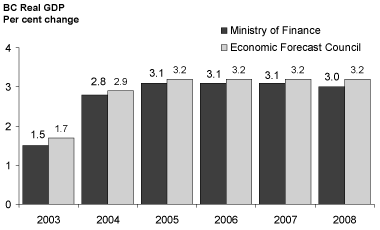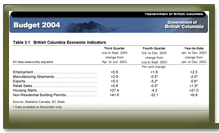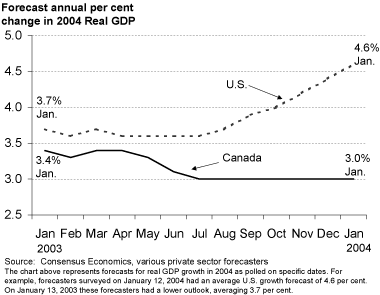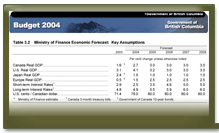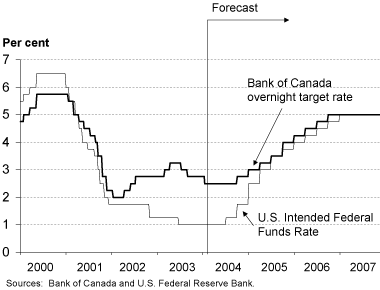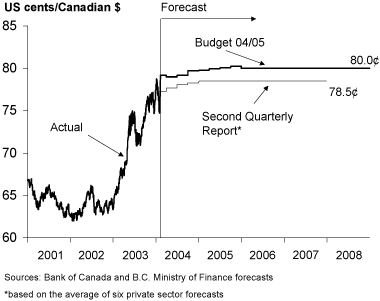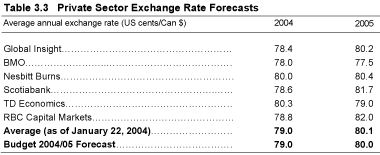 |
|
Part 3: BRITISH COLUMBIA ECONOMIC REVIEW AND OUTLOOK1OverviewBritish Columbia real GDP is forecast to grow 2.8 per cent in 2004 and 3.1 per cent in 2005. The Economic Forecast Council, a group of private sector economists who provide independent advice to the Minister of Finance on the provincial economic outlook, forecasts growth in British Columbia of 2.9 per cent in 2004 and 3.2 per cent in 2005 (see Chart 3.1). From 2006 to 2008, the British Columbia economy is expected to grow about 3.1 per cent per year. The Council's medium-term growth forecast is 3.2 per cent. Following growth of 2.4 per cent in 2002, the Ministry of Finance estimates that the British Columbia economy grew 1.5 per cent in 2003. This is lower than last year's budget forecast of 2.4 per cent, as British Columbia and other Canadian provinces were hit by a number of external shocks in 2003. These included the rapid rise in the Canadian dollar, the SARS outbreak, forest fires, floods and Bovine Spongiform Encephalopathy (BSE). A topic box at the end of Part Three reports on the December 2003 consultation with the Economic Forecast Council.
Recent DevelopmentsChart 3.1 British Columbia economic expansion to continue
The performance of several key economic indicators is presented in Table 3.1. Employment growth picked up steam in the final quarter of 2003 to post annual growth of 2.5 per cent. Housing starts grew 21.0 per cent in 2003 and reached a six-year peak in the July through September quarter. Net interprovincial migration increased by 2,614 people in the third quarter of 2003, the first net increase in interprovincial migration since 1997. The rise in interprovincial migration combined with a net gain of almost 6,000 international migrants resulted in total net migration increasing 8,606 people in the third quarter of 2003. The value of non-residential building permits increased 6.8 per cent in 2003, despite a weak performance in the fourth quarter. Both manufacturing shipments and exports declined in the first eleven months of 2003 relative to the same period in 2002. Retail sales increased modestly on a year-to-date basis to November, with growth of 1.9 per cent.
The Outlook for the External EnvironmentThe North American economy benefited from the recovery of the U.S. economy in 2003. Economic growth in the U.S. gained strength throughout the year, posting 8.2 per cent annualized growth in the third quarter and 4.0 per cent in the fourth quarter. By mid-year, U.S. growth was more broadly-based as business sector investment picked up in response to improving profits. This gave rise to increased confidence that the recovery would be sustained. However, the labour market was slow to show signs of improvement. Payroll employment in the U.S. fell 0.2 per cent in 2003 and some analysts expect it will continue to stagnate until mid-2004. Overall, the U.S. economy grew 3.1 per cent in 2003, up from 2.2 per cent in 2002. Business investment rebounded in the latter half of 2003 to post growth of 2.8 per cent for the year. U.S. retail sales were up 5.6 per cent in 2003 as low interest rates and the strong housing market continued to boost durable goods sales. In addition, tax cuts and tax rebates helped spur consumer spending. Residential construction was strong in 2003 with housing starts reaching 1.8 million units, an increase of 8.1 per cent from 2002. The outlook remains strong for residential construction with continued low mortgage rates and a stabilizing job market. The January Consensus Economics survey forecasts a strong performance in the business sector of the U.S. economy. Corporate profits are expected to increase 15.3 per cent in 2004 and 6.5 per cent in 2005. Business investment is also expected to be strong with growth forecast at 10.5 per cent for 2004 and 9.0 per cent for 2005. Chart 3.2 Consensus outlook for the U.S. has improved
Forecasters have been raising their outlook for the U.S. economy since mid-2003. The January Consensus Economics survey suggests real GDP growth of 4.6 per cent in 2004, compared to 4.4 per cent in its December survey. Forecasters see U.S. growth leveling off in 2005 as some of the U.S. tax cuts expire and the Federal Reserve begins to raise interest rates. Consensus Economics indicates 3.6 per cent growth in the U.S. for 2005. The Ministry of Finance assumes U.S. economic growth will be 4.1 per cent in 2004, somewhat below the current 4.6 per cent consensus. In 2005, U.S. growth is expected to moderate to 3.2 per cent, followed by 3.0 per cent per year over the medium-term. Interest rates are forecast to rise slowly in the U.S., removing the monetary stimulus currently at work in the U.S. economy and resulting in more moderate growth in 2005 and beyond. The Ministry of Finance's growth assumptions are somewhat lower than the consensus, reflecting concerns over the durability of the U.S. recovery and the twin fiscal and current account deficits in the U.S.
The Canadian economy was battered by a number of shocks last year. Although a year ago most analysts expected Canada to grow faster than the U.S., growth is now expected to be just over half of that in the U.S., growing an estimated 1.6 per cent in 2003. This was largely due to the rapid appreciation of the Canadian dollar relative to the U.S. dollar. Unlike the U.S., employment in Canada was robust in 2003, rising 2.2 per cent, an addition of 333,600 jobs. Low interest rates spurred the housing market but retail sales have been weaker than last year. Canadian retail sales increased 3.3 per cent in the first eleven months of 2003, about half the growth rate seen a year earlier. Many firms that export mainly to the U.S. had difficulty adjusting to the rapid rise in the Canadian dollar. Firms in central Canada were particularly hard hit with its heavy dependence on the factory sector, such as auto parts. The Ministry of Finance forecast assumes the Canadian economy will continue to underperform the U.S. economy in 2004, with growth of 2.7 per cent, as the high Canadian dollar dampens growth somewhat. In 2005 and beyond, Canadian economic growth is expected to return to growth on par with the U.S. at around 3.0 per cent. This is slightly lower than the January survey of Consensus Economics, which suggested Canadian growth of 3.0 per cent in 2004 and 3.3 per cent in 2005. Economic conditions in Japan improved in 2003, with real GDP growing an estimated 2.4 per cent. However, most analysts do not see this growth rate continuing over the medium-term. The Ministry of Finance is expecting Japan's economy to grow 1.5 per cent in 2004 and 1.0 per cent over the medium-term. In Europe, Germany's economy continues to struggle with weak consumer spending and poor employment prospects. Overall, Europe should benefit from a pick up in the global economy, led by the U.S. and Asia, but the near term outlook remains weak. In 2004, Europe is expected to grow 1.5 per cent, rising to 2.5 per cent in 2005 and thereafter. Financial MarketsThe U.S. federal funds rate has been relatively steady over the past two years with only two changes to this key interest rate: a 50 basis point reduction in November of 2002 and a 25 basis point reduction in June of 2003. The federal funds rate now stands at 1.0 per cent. The Bank of Canada raised the overnight target rate by 25 basis points in March and again in April. However, it reversed these moves by cutting 25 basis points in both its July and September policy announcements. As a result, the overnight target rate in Canada ended the year at 2.75 per cent, the same level it began 2003. In January of 2004, the Bank of Canada reduced its key policy rate by 25 basis points to 2.50 per cent, citing the rapid appreciation of the dollar and the subsequent downward pressure on Canadian economic growth. Chart 3.3 Interest rates are forecast to rise
Chart 3.4 Canadian dollar strength continues
|
|||||||||||||||||||||||||||||||||||||||||||||||||||||||||||||||||||||||||||||||||||||||||||||||||||||||||||||||||||||||||||||||||||||||||||||||||||||||||||||||||||||||||||||||||||||||||||||||||||||||||
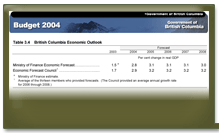 |
Table 3.4 British Columbia Economic Outlook. | ||
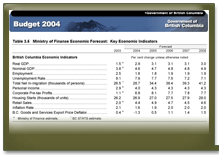 |
Table 3.5 Ministry of Finance Economic Forecast: Key Economic Indicators. | ||
External Trade and Commodity Markets
In the January to November period of 2003, the value of merchandise exports fell 0.6 per cent compared to the same period of the previous year. Despite rising lumber prices in the second half of 2003, exports of forest products fell about ten per cent year-to-date to November, as prices were weak early in the year and the exchange rate started its upward rise. On the upside, energy exports rose 43.5 per cent in the first eleven months of 2003 over the same period the previous year. The value of merchandise exports excluding energy fell 7.0 per cent in the January to November period of 2003.
Chart 3.5 Natural Gas Prices
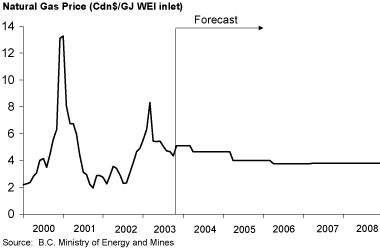
Canadian natural gas prices rose quickly in the first three months of 2003, peaking at C$8.3/GJ in March before falling back to the C$4.0 to C$5.0/GJ range. Nevertheless, natural gas prices were up 88 per cent in the first ten months of 2003 over the same period in 2002.
Overall, the average price of British Columbia goods and services exports grew an estimated 0.4 per cent in 2003 as higher prices for key commodities including lumber, pulp, copper, gold and natural gas rose faster than the Canadian dollar.
Outlook
Real exports of goods and services are expected to pick up in 2004 to 4.2 per cent growth, as British Columbia's largest trading partner, the U.S., posts strong economic growth. Natural gas prices are expected to stabilize, and are forecast to level off at C$3.8/GJ in the medium-term. Spruce-pine-fir prices are expected to remain at $US300 per thousand board feet for 2004 and through the forecast period.
The average price of British Columbia goods and services exports is forecast to decline 1.3 per cent in 2004 as the higher Canadian dollar reduces the value of exporters sales. The average export price is then expected to pick up gradually over the medium-term as commodity prices continue to firm and the Canadian dollar remains around 80 cents US.
Chart 3.6 Export trends reflect stronger U.S. growth
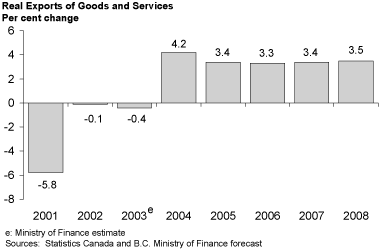
The Labour Market
Employment in British Columbia averaged 2,023,300 persons in 2003, up 2.5 per cent from the previous year, a gain of almost 50,000 jobs (see Chart 3.7). The jobs created in British Columbia in 2003 were almost all full-time, with part-time employment also posting a small gain over the year. Job growth in British Columbia was broadly based with employment in both the goods and services sectors expanding in 2003. From December 2002 to January 2004, employment grew faster than the annual averages, posting an increase of 84,400 jobs. The unemployment rate averaged 8.1 per cent in 2003, down from 8.5 per cent in 2002, as employment gains outweighed the annual growth in the labour force. In January of 2004, British Columbia's unemployment rate was 7.3 per cent.
Chart 3.7 Significant employment gains in 2003
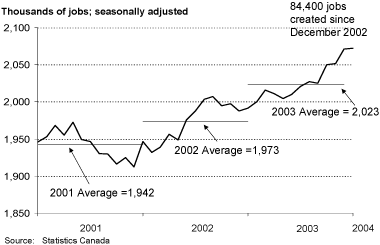
Outlook
Employment is forecast to grow 1.8 per cent, or about 36,000 new jobs in each of 2004 and 2005. The unemployment rate in British Columbia is forecast to continue its decline as employment gains outpace labour force growth. In 2004, the average unemployment rate is forecast at 7.9 per cent, falling to 7.7 per cent in 2005.
Chart 3.8 Unemployment rate forecast to decline
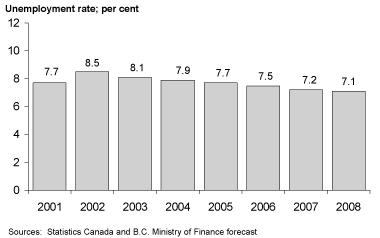
Domestic Demand
Consumer Spending and Housing
Retail sales in 2003 were dampened by a number of external shocks that affected the Canadian and British Columbia economies, such as the SARS outbreak and increased security concerns. The value of retail sales rose 1.9 per cent in the first eleven months of 2003, compared to the same period in 2002.
Aggressive dealer incentives and low auto loan rates resulted in strong motor vehicle sales in 2002. As a result, demand for new vehicles was substantially weaker in the first eleven months of 2003. Sales of other durable goods, such as household appliances and furniture performed well so far in 2003, supported by the high level of housing activity. The value of fuel sales rose strongly in 2003, due to higher market prices for gasoline.
Chart 3.9 Housing starts
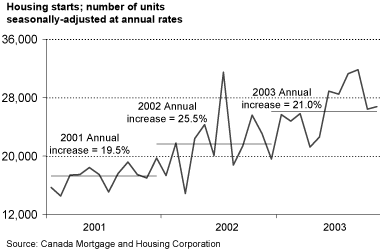
Residential construction was a source of strength in the British Columbia economy in 2003. Low mortgage rates and robust employment gains resulted in continued strong growth in housing demand. Housing starts totalled 26,174 units in 2003, a 21.0 per cent increase over 2002. This was the highest level of housing starts seen since 1997.
Outlook
Consumer demand for goods and services adjusted for inflation is expected to rise 3.1 per cent in 2004, supported by continued low interest rates as well as steady employment and personal income growth. Further growth of 3.3 per cent is expected in 2005 and then 2.7 per cent growth on average in 2006 through 2008.
Chart 3.10 Housing starts to remain robust
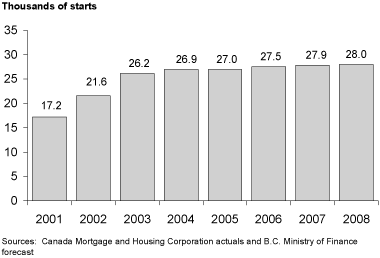
Housing starts are forecast to total 26,900 units in 2004 and 27,000 units in 2005. From 2006 to 2008, housing starts are expected to continue to expand, gradually reaching 28,000 units by 2008.
Business and Government
Business investment (including residential) is estimated to have expanded 4.0 per cent in 2003 after falling 2.6 per cent in 2002. Investment in machinery and equipment benefited from the higher Canadian dollar, which resulted in lower costs for many industries importing equipment from the U.S. In addition, the provincial government exempted production machinery and equipment from the social services tax starting in 2001 in order to encourage business investment.
The Ministry of Finance estimates that investment in machinery and equipment rose 3.4 per cent in 2003, while non-residential construction investment is estimated to have fallen 0.1 per cent. Corporate profits in British Columbia are estimated to have recovered somewhat in 2003 after a decline in 2002. However, the ongoing softwood lumber dispute with the U.S. continues to put downward pressure on corporate profits.
Spending by the three levels of government (local, provincial and federal) is estimated to have risen 0.8 per cent in 2003 in inflation-adjusted terms.
OutlookTotal investment in British Columbia is forecast to grow 6.5 per cent in 2004 and 4.0 per cent in 2005. The strong growth in 2004 results from a combination of a pick up in business investment, in both machinery and equipment and non-residential construction, and public sector investment in capital projects.
In the medium-term, total investment is expected to grow 4.1 per cent a year on average due to increased business investment in machinery and equipment and non-residential structures, by the oil and gas, high-tech and other manufacturing sectors that include the electronic, communications and biotech industries.
In inflation-adjusted terms, spending by the three levels of government, which makes up 20 per cent of the provincial economy, is expected to decline a combined 1.6 per cent in 2004 and then rise 1.4 per cent in 2005. Over the 2006 to 2008 period, inflation-adjusted government spending is forecast to average 2.6 per cent growth per year. This incorporates the provincial government's three-year fiscal plan that includes balanced budgets beginning in 2004/05.
Inflation
The beginning of 2003 was characterized by high consumer price inflation due to rising fuel prices, including gasoline and natural gas, as well as higher insurance premiums across the country. In Canada, consumer price inflation was well above the Bank of Canada's 1 to 3 per cent target range for the first three months of 2003, averaging 4.5 per cent. Prices began to moderate mid-year and had returned to more normal levels by the end of 2003. Overall, inflation in Canada averaged 2.8 per cent for 2003, while British Columbia experienced lower inflation of 2.1 per cent for the year.
Outlook
Consumer price inflation in British Columbia is expected to moderate in 2004 to 1.6 per cent, rising to 1.9 per cent in 2005. Over the medium-term, inflation is forecast to average 2.0 per cent, in line with the Bank of Canada's inflation target.
Risks to the Economic Outlook
The economic outlook has risks on both the upside and downside. The most significant risks to the British Columbia economic outlook remain the durability of the U.S. recovery and exchange rate volatility.
The British Columbia economy could grow faster than forecast if:
- Canada and the U.S. return to the high-productivity fuelled growth recorded in the late 1990s, generating stronger demand for goods and services in the medium-term.
- A durable solution to the softwood lumber dispute is reached, which, alongside growing U.S. demand, would provide an opportunity for growth in British Columbia's forest industry.
- Visitors to B.C. increase as Vancouver gains further international recognition as a tourism destination through promotion of the 2010 Winter Olympic Games. The successful Vancouver/Whistler bid should also boost the outlook in the longer-term as infrastructure spending gets underway.
- British Columbia business confidence and investment strengthen further; this would provide a base for stronger economic growth in the province.
- Interprovincial net in-migration to British Columbia turns around more quickly than forecast; this would generate additional demand for goods and services and housing that would boost economic growth.
Alternatively, the British Columbia economy could grow slower than forecast if:
- The Canadian dollar rises sharply above the current forecast.
- The U.S. must cut government spending or raise taxes to deal with its large fiscal deficit, resulting in a fiscal drag on economic growth.
- Geopolitical uncertainty rises due to increased tensions in the Middle East and other global hot spots.
- Tourism in B.C. does not recover from the impact of global terrorism and the SARS outbreak as quickly as anticipated.
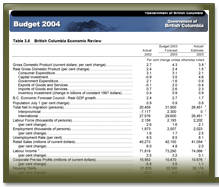 |
Table 3.6 British Columbia Economic Review. | ||
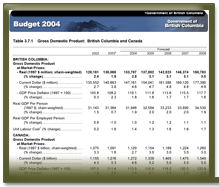 |
Table 3.7.1 Gross Domestic Product: British Columbia and Canada. | ||
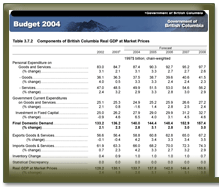 |
Table 3.7.2 Components of British Columbia Real GDP at Market Prices. | ||
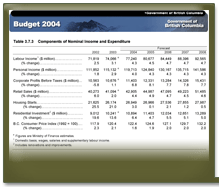 |
Table 3.7.3 Components of Nominal Income and Expenditure. | ||
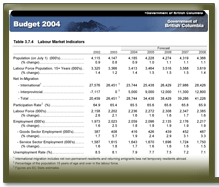 |
Table 3.7.4 Labour Market Indicators. | ||
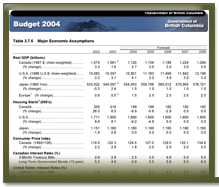 |
Table 3.7.5 Major Economic Assumptions. | ||
 |
||||
